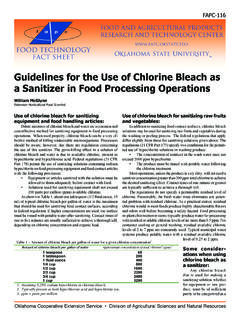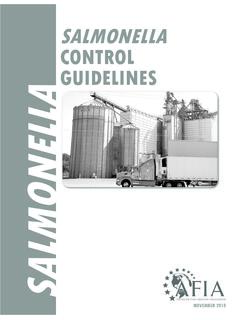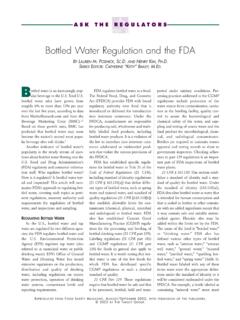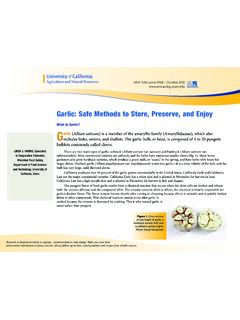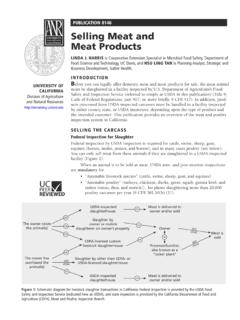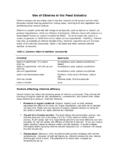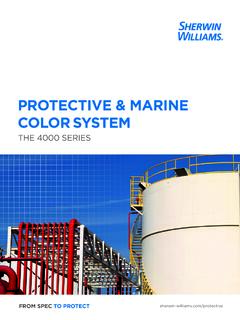Transcription of Sanitary Design and Construction of Food Equipment
1 FSHN0409 Sanitary Design and Construction of food Equipment1 Ronald H. Schmidt and Daniel J. Erickson21. This document is FSHN04-09, one of a series of the food Science and Human Nutrition Department, Florida Cooperative Extension Service, Institute of food and Agricultural Sciences, University of Florida. Original publication date May 2005. Reviewed: May 2008. Visit the EDIS Web Site at Ronald H. Schmidt, PhD, food Science and Human Nutrition Department, University of Florida, Gainesville, FL 32611; and Daniel J. Erickson, Harold Wainness and Associates, St. Paul, MN use of trade names in this publication is solely for the purpose of providing specific information. UF/IFAS does not guarantee or warranty the products named, and references to them in this publication does not signify our approval to the exclusion of other products of suitable composition. The Institute of food and Agricultural Sciences (IFAS) is an Equal Opportunity Institution authorized to provide research, educational information and other services only to individuals and institutions that function with non-discrimination with respect to race, creed, color, religion, age, disability, sex, sexual orientation, marital status, national origin, political opinions or affiliations.
2 Department of Agriculture, Cooperative Extension Service, University of Florida, IFAS, Florida A. & M. University Cooperative Extension Program, and Boards of County Commissioners Cooperating. Larry Arrington, DeanTo ensure safe food and adequate sanitation programs, the Equipment used for processing and handling food products must be designed, fabricated, constructed, and installed according to sound Sanitary Design principles. This ensures the Equipment can be adequately cleaned and sanitized, and that surfaces are resistant to daily exposure to corrosive food products and cleaning/sanitizing chemicals. Equipment that does not meet basic Sanitary Design principles, or is installed or used improperly cannot be adequately cleaned and Standards and Design CriteriaFederal, state, and local regulatory agencies routinely inspect food Equipment for general Sanitary fabrication, Construction , and Design as well as proper installation.
3 The US Department of Agriculture (USDA)/ food Safety & Inspection Service (FSIS) pre-approves Equipment for use in meat, poultry, and egg product facilities (FSIS, 2004). Similarly, the USDA/Agricultural Marketing Service (AMS)/Dairy Division ( ) has an approval process for Equipment used in manufactured dairy facilities under their inspection. food and Drug Administration (FDA) inspectors follow Current Good Manufacturing Practices (cGMPs) which generally address the fabrication and cleanability of food Equipment (FDA, 2004a). In addition, the FDA has developed a general Equipment evaluation program for Equipment used in Grade A Dairy Facilities (FDA, 2000). Standards for Sanitary fabrication, Construction , and Design of food Equipment have been developed by a variety of standards organizations. While there are subtle differences between these standards, the primary intent of each organization is the application of sound Sanitary principles in food Equipment manufacture.
4 In the US, the primary food Equipment organizations are 3-A Sanitary Standards, Inc. ( ), the National Sanitation Foundation (NSF) ( ), and Underwriters Laboratories ( ), which has more recently become involved in food Equipment standards development as Sanitary Standards have been developed for a variety of Equipment used in the dairy industry , as well as some Equipment used in egg processing. The Sanitary Design and Construction of food Equipment2founding organizations of 3A represent Equipment manufacturers, dairy processors, and regulatory officials. 3A Standards are used as a reference under the Grade A Pasteurized Milk Ordinance (PMO), the official regulatory document for the National Conference on Interstate Milk Shipments (NCIMS). 3-A Sanitary Standards may also be required under many state and local regulations. The National Sanitation Foundation (NSF) traditionally has developed standards for Equipment used in food service and retail foods.
5 In more recent years, the NSF has been involved in developing standards for food processing Equipment . The NSF and 3A have recently collaborated in standards development for meats and poultry Equipment (3-A/NSF 15159) which has been under review by an International Organization for Standardization (ISO) working European Hygienic Design Group (EHEDG) is the primary organization for food Equipment approval in Europe. While EHEDG has published a series of guidelines for the Construction and Design of food processing Equipment , they have chosen not to issue standards. Acceptance for food processing Equipment used in some European countries is based upon "cleanability" testing performed in EHEDG laboratories. International trade associations [ International Dairy Federation (IDF)], and international standards organizations [ Codex Alimentarius and the ISO are also generally involved in Equipment hygiene standards.]
6 Some of these organizations have symbol or insignia use authorization programs that require third party verification of compliance with the appropriate standard or Aspects of Sanitary Construction and Design of food EquipmentThe surfaces of food Equipment can be subdivided into two categories:1. food product contact surfaces, and2. non-product contact surfaces. A food product contact surface is defined as a surface in "direct contact with food residue, or where food residue can drip, drain, diffuse, or be drawn" (FDA, 2004b). Because these surfaces, if contaminated, can directly result in food product contamination, rigid Sanitary Design criteria must be met. Non-product contact surfaces are those that are part of the Equipment ( , legs, supports, housings) that do not directly contact food . As contamination of non-product contact surfaces can cause indirect contamination of the food product, these surfaces cannot be ignored with regard to Sanitary Product Contact Surfaces In terms of Sanitary Design , all food contact surfaces should be: smooth; impervious; free of cracks and crevices; nonporous; nonabsorbent; non-contaminating; nonreactive; corrosion resistant; durable and maintenance free; nontoxic; and the surface is coated with metal alloy or non-metal ( ceramics, plastic, rubber) in any way, the final surface must meet the above requirements.
7 3A Standards require that such coatings maintain corrosion resistance, and be free of surface delamination, pitting, flaking, chipping, blistering, and distortion under conditions of intended use. Similarly, if any other modification or process is used in fabrication ( , welded, bonded, or soldered) it should be done using appropriate materials and in a manner that ensures the final surface meets the Sanitary Design Design and Construction of food Equipment3 MaterialsA variety of materials are used in the Construction and fabrication for different applications in food Equipment . These materials vary in their properties with regard to workability, compatibility, and Sanitary Design features. Depending upon the application, various metals as well as non metals ( , plastics, rubber) are used. Some materials are not recommended and should be Stainless steel is the preferred general use metal for food contact surfaces because of its corrosion resistance and durability in most food applications.
8 However, not all stainless steel is equal. In general, the properties of the stainless steel alloy are related to its relative composition with regard to chromium and nickel level. Corrosion resistance varies with chromium level, and structural strength varies with nickel level. The relative levels of these components are often given as a ratio. For example, the American Iron and Steel Institute (AISI) 300 Series Stainless Steel, commonly recommended for food contact surfaces is also termed 18/8 indicating that it is 18% Cr and 8% Ni. 3A Sanitary Standards require 316 (or 18/10) stainless steel for most surfaces. They allow the use of 304 stainless steel only for utility usage ( pipes), and restrict the use of 303 stainless steel. 3A Standards also provide specifications regarding alloys and other coatings used in fabrication. The properties of stainless steel can change with continued use, especially under conditions where the chromium oxide layer is altered ( incompatible cleaners, abrasive cleaners, abrasive cleaning pads, or chlorine and related sanitizers).
9 Therefore, it is recommended that surfaces be passivated (using nitric acid or other strong oxidizing agents) initially and on a regular frequency thereafter, to maintain a passive (non-reactive) oxide film on the surface. Passivation of stainless steel food contact surfaces is recommended after any surface repair, polishing, or working. Titanium has excellent durability and corrosion resistance (especially in an acidic environment) . However, its use is limited by high cost. Titanium is used in stainless steel alloys for food Equipment used in the processing of food products with high acid and/or salt content ( , citrus juice, tomato products). Platinum, another excellent corrosion resistant material, would also be highly desirable, but, obviously, the cost of this rare material would prohibit its use. Gold has been approved as a food contact surface in certain 3-A Sanitary Standards. In some cases, gold is used for soldering optical sensors ( , fiber optics) into stainless steel fittings.
10 Gold is desirable in these applications for its resistance to abrasion and compatibility with metals are limited by application as follows: Copper is primarily used for Equipment used in the brewing industry , with some use for cheese vats in Swiss cheese manufacture, due to tradition. Care should be used with copper Equipment when processing acid products, as copper residues can leach into the product. Aluminum is used in certain parts and components where lighter weight is desired. However, aluminum has poor corrosion resistance and can become pitted and cracked with continued use. Care should taken when cleaning and sanitizing aluminum components as oxidizing chemicals can accelerate the pitting of the metal. In most food contact applications, aluminum must be coated with an acceptable material. Plastic coatings such as polytetrafluorethylene (PTFE or Teflon )are common. Carbonized metal and cast iron are only used for frying and cooking surfaces, and similar applications in food service.
